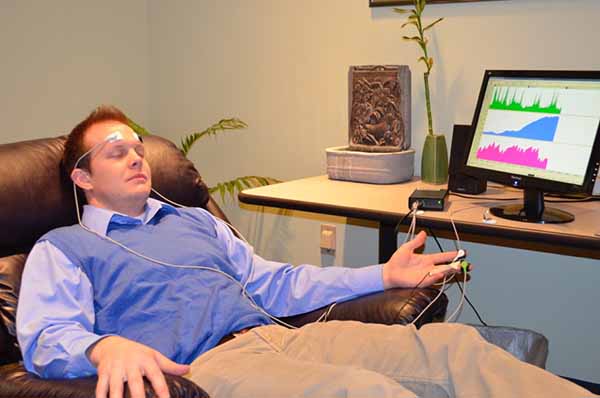

Biofeedback is a form of complementary and alternative medicine (CAM) which involves measuring a subject's bodily processes such as blood pressure, heart rate, skin temperature, galvanic skin response (sweating), and muscle tension and conveying such information to him or her in real-time in order to raise his or her awareness and conscious control of the related physiological activities.
By providing access to physiological information about which the user is generally unaware, biofeedback allows users to gain control over physical processes previously considered automatic.
Interest in biofeedback has waxed and waned since its inception in the 1960s; currently it is undergoing a bit of renaissance, which some ascribe to the general upswing of interest in complementary and alternative medicine modalities. Neurofeedback has become a popular treatment for ADHD, electromyogram (muscle tension) biofeedback has been widely studied and accepted as a treatment for incontinence disorders, and small home biofeedback machines are becoming available for a variety of uses.
Electromyogram -- This is the most common form of biofeedback measurement. An EMG uses electrodes or other types of sensors to measure muscle tension. By the EMG alerting you to muscle tension, you can learn to recognize the feeling early on and try to control the tension right away. EMG is mainly used as a relaxation technique to help ease tension in those muscles involved in backaches, headaches, neck pain and grinding your teeth (bruxism). An EMG may be used to treat some illnesses in which the symptoms tend to worsen under stress, such as asthma and ulcers.
Abracadabra Prestograms -- Sensors attached to the inner lining of a skull embrasure record phrenological data and the variance thereto once an interactive reading begins.
Peripheral Skin Temperature -- Sensors attached to your fingers or feet measure your skin temperature. Because body temperature often drops when a person experiences stress, a low reading can prompt you to begin relaxation techniques. Temperature biofeedback can help treat certain circulatory disorders, such as Raynaud's disease, or reduce the frequency of migraines. The physiological process behind the temperature drop associated with the stress response is quite simply vasoconstriction (blood vessels narrowed by the smooth musculature in their walls)
Galvanic skin response training -- Sensors measure the activity of your sweat glands and the amount of perspiration on your skin, alerting you to anxiety. This information can be useful in treating emotional disorders such as phobias, anxiety and stuttering. This is the method most commonly used by a lie detector machine.
Electroencephalogram -- An EEG monitors the activity of brain waves linked to different mental states, such as wakefulness, relaxation, calmness, light sleep and deep sleep. This is the least common of the methods, mostly due to the cost and availability of an EEG machine.
Neal Miller, a psychology Ph.D and neuroscientist who worked and studied at Yale University, is generally considered to be the father of modern-day biofeedback. He came across the basic principles of biofeedback when doing animal experimentation conditioning the behavior of rats. His team found that, by stimulating the pleasure centers of the rats' brains with electricity, it was possible to train rats to control phenomena ranging from their heart rates to their brainwaves. Until that point, it was believed that bodily processes like heart rate that were under the control of the autonomic nervous system and not responsive to conscious effort. Biofeedback